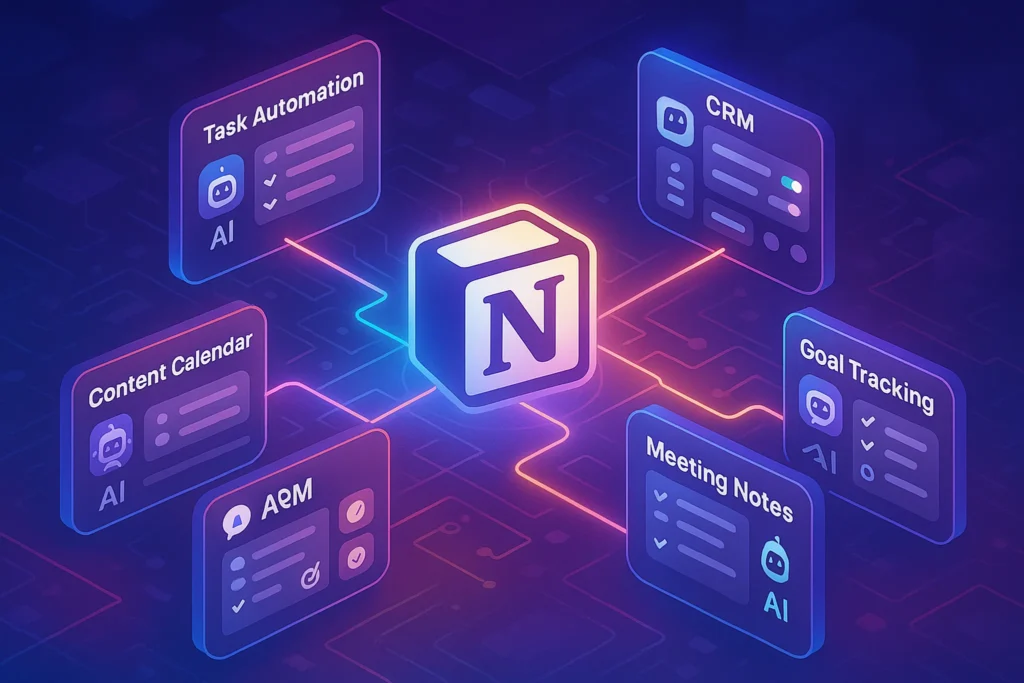-This post may contain affiliate links. If you click on one and make a purchase, I may earn a small commission at no extra cost to you.-
🧠 Introduction – Turn Your Notion Designs into a Business
Notion templates are one of the most in-demand digital products sold online. Start from zero—by creating your first template, packaging it elegantly, and selling it on platforms like Gumroad, Lemon Squeezy, or Payhip—with zero upfront cost. This guide will walk you through:
-
Identifying high‑demand template ideas
-
Designing powerful and user-friendly Notion templates
-
Crafting a compelling product listing
-
Setting up on a selling platform (e.g., Gumroad)
-
Promoting your template effectively
-
Automating sales, delivery, and updates
-
Scaling using affiliate tools and customer funnels
By the end, you’ll be equipped to launch your first paid Notion template—even if you’re building solo.
🧩 Step 1: Research & Validate Template Ideas
Start with real demand:
-
Use Reddit (e.g., r/Notion, r/Productivity) and Notion template marketplaces to uncover requests (e.g., “project roadmap”, “OKR tracker”, “content calendar”).
-
Analyze Google Trends or AnswerThePublic to see ascending search interest on query terms like “Notion finance planner” or “Notion habit tracker template”.
-
Validate the idea with a simple survey via Typeform or by posting in Notion communities—gauge interest and what features people need.
Why it matters: Knowing what your audience truly values prevents wasted time and increases your chance of fast sales.
⚙️ Step 2: Design a High-Quality Notion Template
Use these best practices:
-
Clean structure: Divide into clear sections—Dashboard, Archive, Input forms, Views
-
Use databases effectively: Tables, galleries, calendars where needed
-
Add instructions: Include toggle or inline comments explaining usage
-
Customization tips: Allow users to adjust properties like colors, labels, or select default views
-
Performance test: Ensure mobile/tablet layout works, images are optimized, and loading is smooth
Real‑World Use Case:
A solopreneur created a “Solopreneur Business Hub” template including task trackers, finance database, and monthly-review pages—put it live within 72 hours and sold 50 copies in the first week after promoting in community channels.
🎨 Step 3: Create a Standout Product Listing
Your product page is your pitch:
-
Title: “Ultimate Notion Solopreneur Hub – Task, Finance & Templates”
-
Hero Image: Mockup of your dashboard in Notion, not blank pages
-
Description bullets:
-
“Track daily tasks + status views”
-
“Monthly income & expense tracker”
-
“Built-in productivity system with push reminders”
-
-
Preview video: Show how database filters work, go from blank page to inputting real data
-
FAQ section: Answer common queries (e.g., “How do I duplicate?”, “Is it mobile‑friendly?”, “Can I customize it?”)
Psychology Tip: Use social proof (“Over 500 downloads”), urgency (“Limited-time holiday discount”), and a money‑back promise.
🔌 Step 4: Set Up Your Sales Platform
There are three strong options:
| Platform | Pros | Cons |
|---|---|---|
| Gumroad | Easy setup, Stripe built-in, affiliate links | Transaction fees (8.5%+30¢) |
| Lemon Squeezy | Built-in EU VAT handling, license keys | Less marketplace presence |
| Payhip | DRM, bundles, free product option | Smaller user base |
Setup Steps (e.g., Gumroad):
-
Open an account
-
Upload your PDF/Notion template
-
Write compelling copy + preview images
-
Set price ($10–$40 typical)
-
Set up affiliate program (~10–25%)
-
Add license keys if using Lemon Squeezy or Payhip
-
Connect payout (Stripe/PayPal)
🚀 Step 5: Launch & Promotion
Launch checklist:
-
✅ Share in Notion/Create communities
-
✅ Email your network/newsletter
-
✅ Post a demo thread on X and Reddit threads
-
✅ Run Insta Stories + TikTok clips showing template in use
-
✅ Offer early-bird discount or limited-time bonus
Growth hacks:
-
Bundle your template with mini-course
-
Partner with a seller club and use their affiliate bonus
-
Offer a free sample mini‑template in exchange for email opt‑in
📦 Step 6: Automate Delivery & Updates
Automation tools:
-
Gumroad handles delivery and license key emails automatically
-
Use Zapier/Make:
-
Trigger when Notion template or files are updated → Send broadcast email to buyers with new link
-
Tag buyers in MailerLite to send follow-up tutorials after 7 days
-
Why it matters:
Automated updates keep buyers happy—and can help generate more sales through testimonials and repeat purchases.
📈 Step 7: Scale via Affiliate & Partnerships
Set up an affiliate plan:
-
Offer 15–25% commission via Gumroad/Lemon Squeezy
-
Create a simple “Affiliate Kit” PDF: social assets, sample tweets, copy
-
Pitch in Notion-focused newsletters or YouTube influencers
-
Offer bundle deals and bonus commissions for volume sellers
✅ Step 8: Maintain & Iterate
-
Respond to buyer feedback—add features or improvements
-
Periodically publish updates or content around the template to drive long-term traffic
-
Analyze where traffic and sales are coming from—optimize copy accordingly
-
Plan seasonal promotions (e.g., goal‑setting templates in January)
✨ 9. Launch Tactics That Work
A. Leverage Pre‑Launch Buzz
Create anticipation by building momentum before launch:
-
Mailing List Teasers
-
Share sneak peeks of template features in email.
-
Use poll links (e.g., “Which layout do you prefer?”) to engage.
-
-
Beta Tester Group
-
Invite a small group (10–20 people) to test and give feedback in exchange for early access and testimonials.
-
-
Countdown Posts
-
In communities (Notion, Maker, IndieHackers), share “5 days until launch” updates with feature highlights.
-
-
Countdown UI on Landing Page
-
Use Gumroad or landing page widgets to show pre-order status or early-bird offers.
-
👉 Pre-launch tactics build trust and often lead to strong Day‑1 sales.
📣 10. Marketing Channels to Drive Traffic
A. SEO & Content Marketing
-
Write blog posts targeting phrases like “best Notion content planner” or “how to use Notion templates.”
-
Use internal linking—especially to your own posts about “How to Sell Notion Templates Online” or templates you reference.
-
Create supportive lead magnets (e.g., “Free Notion setup guide”) and gate them for email opt‑ins.
B. Social Media Strategy
-
Twitter Threads: Break down template features into a mini-educational thread.
-
Instagram/TikTok Reels: 15–60 second walkthroughs highlighting key sheets in your template.
-
Pinterest Pins: Pin images showing usage scenarios (e.g., “Plan your week with this Notion journal template”).
-
LinkedIn Posts: Share your product roadmap and why you built your template—with a subtle product link.
C. Community Engagement
-
Daily value-sharing in relevant communities (like r/Notion, Notion Made Simple, or Designer Hangout)—but keep self-promotion respectful.
-
Host an AMA (Ask Me Anything) on Twitter Spaces or Discord about building & selling templates.
-
Send guest posts to Notion-focused publications or newsletters—“How I Built Notion Templates That Sell.”
🧰 11. Scaling Your Template Business
A. Bundle and Upsell
-
Bundle multiple complementary templates (e.g., daily planner + content calendar).
-
Offer discounted bundles for combined purchases.
-
Add upsells like a Notion setup video, tutorial PDF, or live Q&A session.
B. Recurring Revenue with Membership
-
Launch a “Notion Mastery” membership where buyers can get monthly updates, templates, or supporting workflows.
-
Use Gumroad’s subscriptions or Patreon integrations to manage recurring payments.
-
Add value through a private Discord group where members share templates and tips.
C. Affiliate Collaborations
-
Partner with other creators who have niches like “finance”, “studying”, or “coaching”.
-
Provide them with a dedicated affiliate link (+ 20% commission) and promotional assets.
-
Run limited-time promo tie-ups (e.g. “Get 2 templates for $29 this week—affiliate collab!”).
📊 12. Advanced Automation Workflows
A. Customer Feedback Collection
-
Use Zapier to import Gumroad purchase data into Typeform/Google Form to auto-email buyers a “Rate your experience” link.
-
Automate monthly email reminders for feedback and updates using MailerLite or ConvertKit.
B. Cross-Sell & Upsell Sequence
-
After purchase, tag customers with “Template Buyer” in your CRM.
-
After 7 days, trigger an email offering a complementary product (e.g., “Need a Notion task tracker?”)
-
One month later, feature your subscription/membership offering.
🔍 13. Legal & Administrative Setup
A. Protecting Intellectual Property
-
Add copyright notices to your template page and listing.
-
Clearly state “© Your Name or Brand Year. All Rights Reserved”
-
Provide license terms (personal use vs. commercial use).
B. Tax & Pricing Considerations
-
Include VAT/Tax disclaimers in your listing (most platforms handle VAT automatically).
-
Think about international pricing: some creators set different pricing in EUR/GBP/INR markets.
C. Providing Support & Updates
-
Set up a simple support email or chat widget for paid users.
-
Understand your refund policy and post it clearly: “14-day refund if unused.”
-
Schedule quarterly template updates (performance improvements, new feature requests).
🌱 14. Case Studies & Testimonials
Adding real success stories adds credibility:
-
Case Study 1: “Laura, solopreneur, sold 100 templates in week 2 by launching on Gumroad + posting 7 TikToks of template walkthrough.”
-
Case Study 2: “Mike grew from 0 to 500 template buyers in 3 months by building email automation and launching bundle upsells.”
-
Testimonials: Include short quotes like:
“Your dashboard changed my workflow—I can’t imagine going back.” — Emma, Productivity Coach
📈 15. Tracking Metrics & Optimizing Growth
-
KPI Recommendations:
-
Sales/month
-
Conversion Rate (product page views → sales)
-
Email list growth
-
Referral traffic (affiliate/partner sources)
-
-
Optimization Tactics:
-
A/B test cover images and titles.
-
Track what content drives the most page views (e.g., via Google Analytics).
-
Use heatmaps or session replays to see where users drop—refine the product page accordingly.
-
💰 16. Monetization Funnel Overview
-
Lead Magnet – Offer a mini free Notion template to build your email list
-
Core Product – Promote your premium template ($15–$40)
-
Upsell – Offer bundles or tutorial add-ons
-
Subscription/Membership – Monthly access to themes, updates, vaults
-
Affiliate Income – Earn from Lemon Squeezy, Zapier, ConvertKit referrals
❓ FAQ
Q1: Can I sell a free Notion template?
Yes—many creators build audience with freebies and convert later. Free samples can help generate interest.
Q2: Should I protect my Notion link?
Provide a read‑only public link. Technical protection is hard, but trust works when you offer value and updates.
Q3: Which platform has the easiest refunds?
Gumroad and Lemon Squeezy handle refunds; Gumroad does it automatically based on your policy.
Q4: Can I sell internationally?
Yes. Platform auto‑applies VAT/Tax (Lemon Squeezy handles EU VAT); Gumroad allows global payments via Stripe/PayPal.
🧠 Nerd Verdict
Selling Notion templates is one of the most accessible online businesses for solopreneurs. The model scales easily across evergreen niches—productivity, lifestyle, education—while automation and affiliates do the heavy lifting.
This guide now covers everything—idea validation, product creation, platform choice, promotion, automation, legal setup, and scaling. You’ll not only launch a great Notion template but also build a sustainable, savvy digital product business.
💬 Would You Bite?
Tell us: Ready to build your first template?
Let me know your niche and I’ll share a prompt to get you started! 👇



